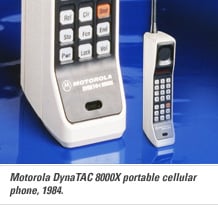"I do not think that the wireless waves I have discovered will have any practical application." —German physicist Heinrich Rudolf Hertz, the first person to broadcast and receive radio waves.
It’s fair to say that Heinrich Rudolf Hertz didn’t quite know what he had on his hands when he discovered the radio wave in 1886, but in his defense, the rest of the world didn’t either. While Hertz’s experiments paved the way for technology including the radio, television and mobile phones, it would be years before scientists fully understood the implications of what he’d uncovered.Let’s take a quick look at how wireless communications have evolved from Hertz’s “impractical” radio waves to some of the indispensable technology we use today.
The Birth of Radio
Engineers continued to build upon Hertz’s experiments, leading to the first radio broadcast in history on Christmas Eve 1906, when Canadian inventor Reginald Fessenden beamed a Christmas concert to commercial and U.S. Navy ships in the Atlantic Ocean from a shoreline post in Massachusetts.
Detroit Police Make History
As commercial use of radio expanded, the Detroit Police Department made history in 1928 by becoming the first to use one-way radio communication with its patrol cars, using it to dispatch officers to crime scenes and transmit alerts about missing children or stolen vehicles. The success in Detroit is just just one milestone in law enforcement’s embrace of emerging technology to prevent and investigate crime, laying the foundation for today’s two-way radios, dispatch systems and command vehicles.
Calling Out Chicago’s Firsts 
As radio use exploded, so did the telephone, first patented by Alexander Graham Bell in 1876. A little over a century later, Japan was the first to un-tether the telephone with a commercial cellular system in 1979. In the United States, the city of Chicago and its suburbs were the testing ground for the first mobile system developed by AT&T Labs in 1983.
Illinois is home to another first in wireless history thanks to the work of Schaumburg-based Motorola, which debuted the world’s first commercial portable cellular phone, the DynaTAC, in 1984. The DynnaTAC, now lovingly referred to as “the brick,” tipped the scales at 28 ounces. Today’s best-selling phones weigh around 5 ounces.
October 13, 1983, David D Meilahn placed the first commercial wireless call on a DynaTAC from his 1983 Mercedes to Bob Barnett, former president of Ameritech Mobile Communications, who then placed a call on a DynaTAC from inside a Chrysler convertible to the grandson of Alexander Graham Bell, who was in Germany for the event. It was also the day Chicago Communications made cellular history. ChiComm installed cellular systems in 15 vehicles (including the 2 previously mentioned) that were taken to the parking lot at Soldier Field. Former Cubs announcer, Jack Brickhouse, gave the play by play of the event. 15 technicians competed in a foot race contest to be the first to insert a NAM card into the transceiver in the trunks of the vehicles. Once finished they would signal to the driver/owner of the car to dial the call. The first cellular mobile phone call was made possible by Chicago Communications courtesy of Bob Barnett in his Chrysler convertible. Read the entire story.
Today, there are an estimated 7.6 billion – with a b – wireless connections worldwide, compared to 7.3 billion human beings.
To meet your needs for state-of-the-art wireless communications technology, contact Chicago Communications today!



